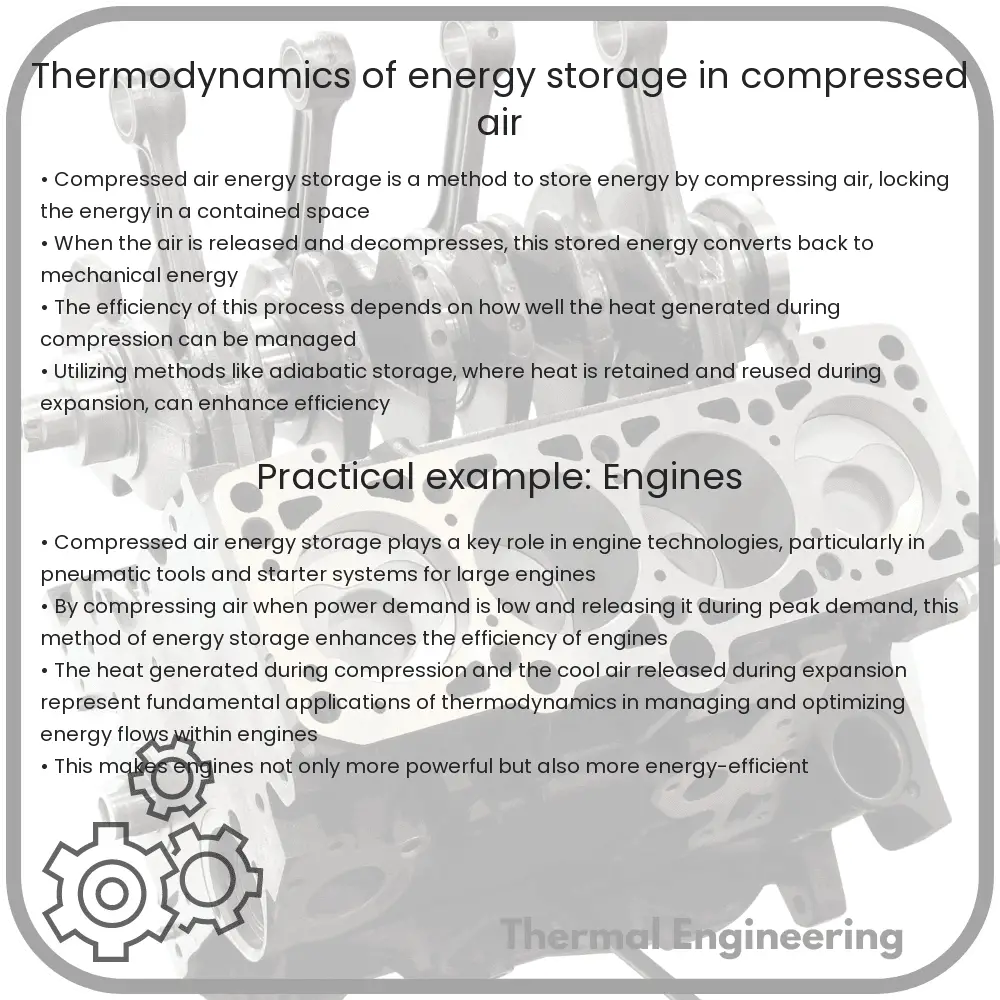Explore the thermodynamics of Compressed Air Energy Storage (CAES), delving into how energy is stored and managed through air compression and expansion processes.

The Thermodynamics of Energy Storage in Compressed Air
Compressed air energy storage (CAES) is an important method used for storing energy on both small and large scales. By compressing air and storing it under high pressure, energy can be saved for future use, often in the context of balancing electrical grids and managing variable power output from renewable energy sources like wind and solar. To understand the efficiency and functionality of CAES systems, it’s crucial to delve into the thermodynamics that governs the process.
Basic Principles of Compressed Air Energy Storage
CAES revolves around two main processes: compression and expansion of air. These processes are inherently thermodynamic, involving changes in pressure, volume, and temperature, which in turn affect the energy stored and released.
Compression of Air
During the compression stage, electrical energy is used to compress air into a storage vessel, which raises the air’s pressure and temperature. According to the ideal gas law (PV = nRT), where P is the pressure, V is the volume, n is the number of moles of gas, R is the universal gas constant, and T is the temperature, compressing the air while maintaining a constant temperature (isothermal compression) is typically ideal for maximizing energy storage. However, in practical situations, compression often occurs adiabatically, meaning it’s done without transferring heat to the environment, which increases the temperature of the air significantly.
Storage and Losses
Once compressed, the air must be stored in airtight containers capable of handling high pressure. The energy is technically stored in the form of pressurized air, but some energy is always lost primarily due to heat generation during compression and friction losses. In advanced CAES systems, this heat is often captured and stored using thermal energy storage systems to improve the overall efficiency of the process.
Expansion of Air
The release of stored energy occurs during the expansion process. When the pressurized air is allowed to expand, it does work on the surroundings (e.g., turning a turbine to generate electricity). Ideally, this process would be isothermal, meaning it would occur at a constant temperature, but similar to compression, it often happens adiabatically resulting in a drop in temperature, which can be mitigated with previously captured heat or external heat sources to increase efficiency.
Efficiency Considerations
The overall efficiency of a CAES system can vary significantly depending on the specific setup and implementation. The efficiency is influenced by factors such as the method of heat management, the degree of adiabatic versus isothermal processes employed, and the specific materials and technologies used in air compressors and expanders.
- The ideal isothermal process provides a theoretical maximum efficiency by maintaining constant temperature.
- Practical adiabatic processes necessitate heat management strategies to approach the efficiency of isothermal processes.
- Material technology improvements can reduce friction and thermal losses during compression and expansion.
In conclusion, the thermodynamics of energy storage in compressed air hinges on efficiently managing the heat produced and utilized during the compression and expansion processes. With advancements in technology and material sciences, the efficiency of CAES systems continues to improve, making it a more viable option for large-scale energy storage in conjunction with renewable energy sources.
Future Directions
Continued research and development are focused on enhancing heat capture and reuse strategies, improving the thermodynamic cycles used in CAES, and integrating new materials that withstand higher pressures and temperatures while minimizing energy losses. These advances will play a crucial role in the future scalability and effectiveness of compressed air energy storage systems.
Understanding these fundamental thermodynamic principles is essential for engineering students, professionals, and anyone interested in the development of sustainable energy storage solutions.